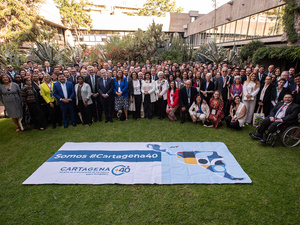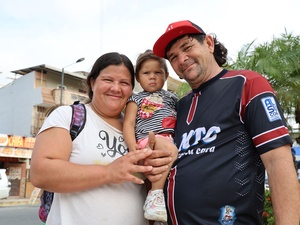Southern Latin America opens its arms to asylum-seekers
Southern Latin America opens its arms to asylum-seekers

Nigerian refugee Davala enjoys an Argentinian hotdog on the street of his vibrant bohemian Buenos Aires neighbourhood, where he dreams of becoming a hip-hop star.
BUENOS AIRES, Argentina, August 27 (UNHCR) - When Davala arrived in Argentina, he expected a huge block of ice stretching to the horizon. The young African was surprised to find instead the immense urban sprawl of Buenos Aires, nothing like the images he had seen long ago in a documentary.
The glaciers, he discovered, are around 3,000 kilometres to the south, and Argentina's capital is as hot in summer as his native Nigeria. Arriving alone in this unknown and distant country was a terrifying prospect for Davala, then only 16, but the Southern Cone (the southernmost countries of South America) is becoming a destination for more and more asylum seekers.
Over the last two years the numbers of claims has doubled in both Chile and Argentina. Even though the figures are far below those in the traditional countries of asylum, statistics show that new humanitarian spaces are once again opening up in countries that at the beginning of the last century absorbed an extraordinary number of immigrants and refugees fleeing from wars and famine in Europe.
"These countries all share a generous definition of refugees, coherent with the problems and challenges in the region," says Federico Agusti, director of the National Commission of Refugees of Argentina. "The Cartagena Declaration of 1984 entails access to international protection as refugees to people who in other countries would not fall under the classic definition of refugees and would not qualify for full protection."
These days those arriving in the Southern Cone come mainly from Colombia and Africa. In Argentina, around 50 percent of asylum claims are from Colombian citizens and almost all the rest are from countries in Africa. In Chile, around 95 percent are Colombians fleeing the spiral of violence in their country.
There have also been important advances in Argentina, Bolivia, Brazil, Paraguay, Peru and Uruguay, which all have national laws encouraging integration and self-sufficiency of refugees, and some countries are beginning to resettle refugees as well.
Countries of the region are also unusual in not detaining foreigners and refugees in camps with restricted rights while awaiting a decision on their case, Agusti says. Still, he adds: "the common challenge is to keep improving the conditions of reception and primary assistance to asylum seekers and to integrate the refugees in urban spaces, where the majority settle."
Less than two decades ago, a large number of refugees fled the military dictatorships in the region seeking protection abroad. After the restoration of democracy, the region is taking on the commitment and responsibility of being part of the solution to the plight of refugees, opening their doors to those who now suffer what, until recently, their own citizens suffered.
"Thousands of women and men had to leave our land and experienced the warmth and humanity of other countries," Chilean president Michelle Bachelet, herself a former refugee, said recently. "Today it is our turn to give because we are now a democratic, free and pluralist society, with good levels of employment, social peace and human development. Today we must extend our hands to those who need us." She has proved her commitment with refugee legislation that is now awaiting approval by parliament.
Argentinian Foreign Affairs Minister Jorge Taiana, another who escaped his own country and found asylum abroad, agrees that "from our experiences of exile, persecution and hardship during the dictatorship, we have learnt to be generous with people in need of protection."
Davala, the young African knew nothing of Argentina's warm welcome for refugees. It was pure chance that he ended up here. He got separated from his mother when the two of them escaped from a prison camp run by the rebels who had killed his father, and he stowed away on a cargo ship - bound for anywhere safe. Once across the ocean, he applied for and was granted refugee status in Argentina and is beginning to rebuild his life in Buenos Aires.
Now almost 19, Davala lives in a room in the central Buenos Aires neighbourhood of San Telmo, the streets of which inspire the hip hop rhymes he composes and recites with friends. Traditionally the home of Italian and Spanish immigrants of 100 years ago, San Telmo is now a fashionable bohemian 'barrio,' popular with foreign tourists and expats, but Davala still dreams that someday he'll live in the mountains - near that glacier he saw long ago in the documentary back in Nigeria.
By Carolina Podestá
In Buenos Aires









